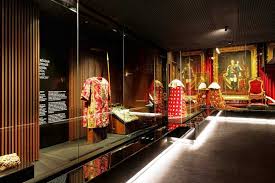The Portugal Royal Treasure Museum has over 1,000 priceless objects

Lisbon: Portugal is a slender strip of land about the size of Maine boarded by Spain in the east and the Atlantic Ocean in the west. Its connection to the sea led the country to spearhead the European exploration of the world, launching what is known as “The Age of Discoveries” beginning in the late 14th century. The Portuguese explored the Indian Ocean and established trade routes in southern Asia. By the early 15th century it began its colonial dominance, first in Africa, then in Asia and South America.
This resulted in a great deal of wealth for the relatively small country, much of which can be seen in the Belém neighborhood in Lisbon, Portugal’s capital and largest city. Overlooking the Atlantic Ocean are monuments, castles, museums, fortresses and expansive gardens that protected the city, celebrate its seafaring history and serve as a visual reminder of its importance in the world.
For Portuguese royalty, it meant acquiring one of the world’s most important collection of gems, jewels and bejeweled objects. It took until 2022 for Portugal to create a museum to showcase this bounty, which first opened to the public in June of 2023.

The Museu do Tesouro Real (Royal Treasure Museum) has a collection of more than 1,000 historic creations including more than 22,000 gems, the majority being diamonds. It is in the west wing of the Ajuda National Palace, the home of the last kings of Portugal. The museum is literally inside one of the largest vaults in the world, and perhaps the only one with a gold-colored aluminum foam façade.
The museum vault is 131 feet long and 32 feet high occupying three floors connected by a long, slanted ramp. It contains bejeweled creations of the former royal house and private collections of the various members of the Portuguese royal family. The collection began after the 1755 earthquake and subsequent fire, which destroyed all of Lisbon, and ended in 1910 when the Portuguese people overthrew the monarchy and established the country’s first Republic.
The museum is in a neoclassical palace and contains objects that span nine centuries. However, the jewels and objects are displayed in a darkened contemporary space. The individual pieces are well-lit behind a continuous glass wall with detailed descriptions beneath each piece.
The collections are shown in a way that portray important moments in Portugal’s history while detailing the extravagance of how royalty lived in the 18th and 19th centuries. The items are organized into 11 sections. They are gold and diamonds from Brazil, coins and medals, jewels, orders of the knighthood and orders of merit, royal insignias, the crown’s silver, private collections, diplomatic gifts, the royal chapel, the royal table and traveling cases for the treasures.
It’s a bit of a fool’s errand to detail all the important objects in the vast collection. But there are certainly standout pieces.
The Bodice Ornament is one such piece. Made of silver, diamonds and Colombian emeralds, with the largest being a 37-carat hexagonal-shaped gem in the center. The ribbon-shaped piece dates to the mid-18th century.
Craftsmanship was just as important as the materials. This is shown in a pair of impeccable opera binoculars made of blonde tortoise shell studded with diamonds. Queen D. Maria Pia purchased the binoculars in 1888.
A total of 43 diamonds of various weights were part of a set of 89 diamonds that were used as buttons for a royal suit and vest.
There’s a diadem and necklace with stars set with diamonds commissioned by Queen D. Maria Pia.
Perhaps the most royal jewel in the collection is a gold crown made in Rio de Janeiro for King João VI.
The jeweled Badge of the Order of the Golden Fleece signifies the power of the kings of Portugal. It is one of the largest royal insignias in the world.
One of the most important objet d’art examples is the tobacco box encrusted with diamonds, with the largest weighing about 30 carats. It was commissioned by King José from a jeweler of French King Louis XV.
French craftsmanship was highly sought after among Portuguese Royality. The best example is the 18th-century stately silver table services displayed on a table setting in the same detailed and elaborate way that royal service was presented. The service was coordinated by dozens of servants specialized in laying and removing the settings through the four stages of a royal banquet. It was commissioned by King D. José I from François-Thomas Germain, a famed French silversmith. A French specialist in historic objects told me that it is by far the best example of French silver in the world.
There are many examples of gold nuggets from Brazil, with the largest being 35.80 carats.
The museum not only serves as a place for the public to view historic treasures, but it serves as a place of research for academics in the fields of museum curation, gemology and royal history.





